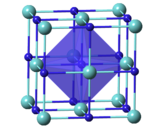
| |

| |
| Names | |
|---|---|
| IUPAC name
Tantalum carbide
| |
| Other names
Tantalum(IV) carbide
| |
| Identifiers | |
| |
3D model (JSmol)
|
|
| ChemSpider |
|
| ECHA InfoCard | 100.031.914 |
| EC Number |
|
PubChem CID
|
|
| UNII |
|
CompTox Dashboard (EPA)
|
|
| |
| |
| Properties | |
| TaC | |
| Molar mass | 192.96 g/mol |
| Appearance | Brown-gray powder |
| Odor | Odorless |
| Density | 14.3–14.65 g/cm3 (TaC) 15.1 g/cm3 (TaC0.5)[1] |
| Melting point | 3,768 °C (6,814 °F; 4,041 K) (TaC)[3] 3,327 °C (6,021 °F; 3,600 K) (TaC0.5)[1] |
| Boiling point | 4,780–5,470 °C (8,640–9,880 °F; 5,050–5,740 K) (TaC)[1][2] |
| Insoluble | |
| Solubility | Soluble in HF-HNO3 mixture[1] |
| Thermal conductivity | 21 W/m·K[2] |
| Thermochemistry | |
Heat capacity (C)
|
36.71 J/mol·K[4] |
Std molar
entropy (S⦵298) |
42.29 J/mol·K |
Std enthalpy of
formation (ΔfH⦵298) |
−144.1 kJ/mol |
| Related compounds | |
Related refractory ceramic materials
|
Zirconium nitride Niobium carbide Zirconium carbide |
Except where otherwise noted, data are given for materials in their standard state (at 25 °C [77 °F], 100 kPa).
| |
Tantalum carbides (TaC) form a family of binary chemical compounds of tantalum and carbon with the empirical formula TaCx, where x usually varies between 0.4 and 1. They are extremely hard, brittle, refractory ceramic materials with metallic electrical conductivity. They appear as brown-gray powders, which are usually processed by sintering.
Being important cermet materials, tantalum carbides are commercially used in tool bits for cutting applications and are sometimes added to tungsten carbide alloys.[5]
The melting points of tantalum carbides was previously estimated to be about 3,880 °C (4,150 K; 7,020 °F) depending on the purity and measurement conditions; this value is among the highest for binary compounds.[6][7] And only tantalum hafnium carbide was estimated to have a higher melting point of 3,942 °C (4,215 K; 7,128 °F).[8] However new tests have conclusively proven that TaC actually has a melting point of 3,768 °C and both tantalum hafnium carbide and hafnium carbide have higher melting points.[9]
- ^ a b c d Lide, David R., ed. (2009). CRC Handbook of Chemistry and Physics (90th ed.). Boca Raton, Florida: CRC Press. ISBN 978-1-4200-9084-0.
- ^ a b US 5196273, Tsantrizos, Peter; Mavropoulos, Lakis T. & Shanker, Kartik et al., "Tantalum carbide composite materials", published 1993-03-23, assigned to Noranda Inc.
- ^ Cedillos-Barraza, Omar; Manara, Dario; Boboridis, K.; Watkins, Tyson; Grasso, Salvatore; Jayaseelan, Daniel D.; Konings, Rudy J. M.; Reece, Michael J.; Lee, William E. (2016). "Investigating the highest melting temperature materials: A laser melting study of the TaC-HFC system". Scientific Reports. 6: 37962. Bibcode:2016NatSR...637962C. doi:10.1038/srep37962. PMC 5131352. PMID 27905481.
- ^ Tantalum carbide in Linstrom, Peter J.; Mallard, William G. (eds.); NIST Chemistry WebBook, NIST Standard Reference Database Number 69, National Institute of Standards and Technology, Gaithersburg (MD) (retrieved 2014-07-02)
- ^ Emsley, John (11 August 2003). Nature's building blocks: an A-Z guide to the elements. Oxford University Press. pp. 421–. ISBN 978-0-19-850340-8. Retrieved 2 May 2011.
- ^ The claim of melting point of 4,000 °C (4,270 K; 7,230 °F) in TaC0.89 is based not on actual measurement but on an extrapolation of the phase diagram, using an analogy with NbC, see Emeléus
- ^ Emeléus, Harry (1968). Advances in Inorganic Chemistry and Radiochemistry. Academic Press. pp. 174–176. ISBN 978-0-12-023611-4. Retrieved 3 May 2011.
- ^ Agte, C.; Alterthum, H. (1930). "Researches on Systems with Carbides at High Melting Point and Contributions to the Problem of Carbon Fusion". Zeitschrift für technische Physik. 11: 182–191. ISSN 0373-0093.
- ^ "New record set for world's most heat resistant material".